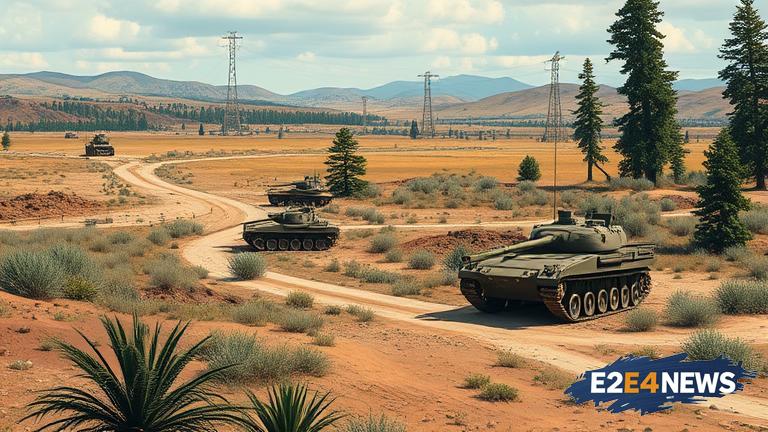The US Army’s training sites have been found to be inadequate in simulating the complexities of future battlefields, according to a recent analysis. This shortfall has significant implications for the military’s ability to prepare for modern warfare. The analysis highlights the need for more realistic and dynamic training environments that can replicate the challenges of urban warfare, cyber attacks, and other emerging threats. The current training sites are largely based on traditional warfare scenarios, which do not account for the evolving nature of modern conflict. As a result, soldiers may not be adequately equipped to handle the complexities of future battlefields. The US Army has acknowledged the need for more advanced training sites, but the process of upgrading existing facilities is slow and hindered by budget constraints. The military is also exploring the use of virtual and augmented reality technologies to enhance training, but these solutions are still in the early stages of development. The lack of realistic training environments is not only a concern for the US Army, but also for other military branches, which face similar challenges in preparing for future conflicts. The analysis notes that the US Army’s training sites are largely focused on traditional warfare scenarios, such as desert or forest environments, which do not account for the urbanization of modern warfare. The military needs to adapt its training sites to reflect the changing nature of conflict, which increasingly involves urban warfare, cyber attacks, and other emerging threats. The use of virtual and augmented reality technologies could help to address this shortfall, but more investment is needed to develop these solutions. The US Army has also recognized the need for more international cooperation and joint training exercises to prepare for future conflicts. The analysis highlights the importance of collaboration between military branches and international partners to develop more effective training programs. The US Army’s training sites are not only used for military training, but also for joint exercises with international partners, which highlights the need for more cooperation and standardization in training programs. The military is also exploring the use of private sector technologies, such as gaming and simulation software, to enhance training. However, the adoption of these technologies is slow due to concerns over security and interoperability. The analysis notes that the US Army’s training sites are largely based on traditional warfare scenarios, which do not account for the evolving nature of modern conflict. The military needs to adapt its training sites to reflect the changing nature of conflict, which increasingly involves urban warfare, cyber attacks, and other emerging threats. The lack of realistic training environments is a significant concern for the US Army, as it may impact the military’s ability to prepare for future conflicts. The analysis highlights the need for more investment in training infrastructure and technologies to address this shortfall. The US Army has recognized the need for more advanced training sites, but the process of upgrading existing facilities is slow and hindered by budget constraints. The military is also exploring the use of virtual and augmented reality technologies to enhance training, but these solutions are still in the early stages of development. The use of private sector technologies, such as gaming and simulation software, could help to address this shortfall, but more investment is needed to develop these solutions. The analysis notes that the US Army’s training sites are not only used for military training, but also for joint exercises with international partners, which highlights the need for more cooperation and standardization in training programs. The military needs to adapt its training sites to reflect the changing nature of conflict, which increasingly involves urban warfare, cyber attacks, and other emerging threats. The lack of realistic training environments is a significant concern for the US Army, as it may impact the military’s ability to prepare for future conflicts. The analysis highlights the need for more investment in training infrastructure and technologies to address this shortfall. The US Army has recognized the need for more advanced training sites, but the process of upgrading existing facilities is slow and hindered by budget constraints. The military is also exploring the use of virtual and augmented reality technologies to enhance training, but these solutions are still in the early stages of development. The use of private sector technologies, such as gaming and simulation software, could help to address this shortfall, but more investment is needed to develop these solutions. The analysis notes that the US Army’s training sites are not only used for military training, but also for joint exercises with international partners, which highlights the need for more cooperation and standardization in training programs. The military needs to adapt its training sites to reflect the changing nature of conflict, which increasingly involves urban warfare, cyber attacks, and other emerging threats. The lack of realistic training environments is a significant concern for the US Army, as it may impact the military’s ability to prepare for future conflicts. The analysis highlights the need for more investment in training infrastructure and technologies to address this shortfall. The US Army has recognized the need for more advanced training sites, but the process of upgrading existing facilities is slow and hindered by budget constraints. The military is also exploring the use of virtual and augmented reality technologies to enhance training, but these solutions are still in the early stages of development. The use of private sector technologies, such as gaming and simulation software, could help to address this shortfall, but more investment is needed to develop these solutions.
